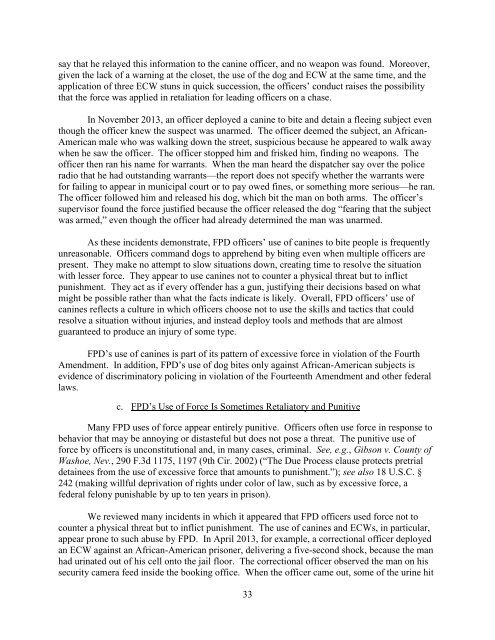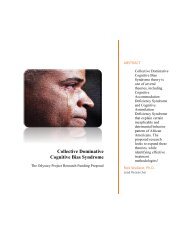U.S. Justice Department Report on the Ferguson Police Department
Ferguson’s law enforcement practices are shaped by the City’s focus on revenue rather than by public safety needs. This emphasis on revenue has compromised the institutional character of Ferguson’s police department, contributing to a pattern of unconstitutional policing, and has also shaped its municipal court, leading to procedures that raise due process concerns and inflict unnecessary harm on members of the Ferguson community.
Ferguson’s law enforcement practices are shaped by the City’s focus on revenue rather than by public safety needs. This emphasis on revenue has compromised the institutional character of Ferguson’s police department, contributing to a pattern of unconstitutional policing, and has also shaped its municipal court, leading to procedures that raise due process concerns and inflict unnecessary harm on members of the Ferguson community.
Create successful ePaper yourself
Turn your PDF publications into a flip-book with our unique Google optimized e-Paper software.
say that he relayed this informati<strong>on</strong> to <strong>the</strong> canine officer, and no weap<strong>on</strong> was found. Moreover,<br />
given <strong>the</strong> lack of a warning at <strong>the</strong> closet, <strong>the</strong> use of <strong>the</strong> dog and ECW at <strong>the</strong> same time, and <strong>the</strong><br />
applicati<strong>on</strong> of three ECW stuns in quick successi<strong>on</strong>, <strong>the</strong> officers’ c<strong>on</strong>duct raises <strong>the</strong> possibility<br />
that <strong>the</strong> force was applied in retaliati<strong>on</strong> for leading officers <strong>on</strong> a chase.<br />
In November 2013, an officer deployed a canine to bite and detain a fleeing subject even<br />
though <strong>the</strong> officer knew <strong>the</strong> suspect was unarmed. The officer deemed <strong>the</strong> subject, an African-<br />
American male who was walking down <strong>the</strong> street, suspicious because he appeared to walk away<br />
when he saw <strong>the</strong> officer. The officer stopped him and frisked him, finding no weap<strong>on</strong>s. The<br />
officer <strong>the</strong>n ran his name for warrants. When <strong>the</strong> man heard <strong>the</strong> dispatcher say over <strong>the</strong> police<br />
radio that he had outstanding warrants—<strong>the</strong> report does not specify whe<strong>the</strong>r <strong>the</strong> warrants were<br />
for failing to appear in municipal court or to pay owed fines, or something more serious—he ran.<br />
The officer followed him and released his dog, which bit <strong>the</strong> man <strong>on</strong> both arms. The officer’s<br />
supervisor found <strong>the</strong> force justified because <strong>the</strong> officer released <strong>the</strong> dog “fearing that <strong>the</strong> subject<br />
was armed,” even though <strong>the</strong> officer had already determined <strong>the</strong> man was unarmed.<br />
As <strong>the</strong>se incidents dem<strong>on</strong>strate, FPD officers’ use of canines to bite people is frequently<br />
unreas<strong>on</strong>able. Officers command dogs to apprehend by biting even when multiple officers are<br />
present. They make no attempt to slow situati<strong>on</strong>s down, creating time to resolve <strong>the</strong> situati<strong>on</strong><br />
with lesser force. They appear to use canines not to counter a physical threat but to inflict<br />
punishment. They act as if every offender has a gun, justifying <strong>the</strong>ir decisi<strong>on</strong>s based <strong>on</strong> what<br />
might be possible ra<strong>the</strong>r than what <strong>the</strong> facts indicate is likely. Overall, FPD officers’ use of<br />
canines reflects a culture in which officers choose not to use <strong>the</strong> skills and tactics that could<br />
resolve a situati<strong>on</strong> without injuries, and instead deploy tools and methods that are almost<br />
guaranteed to produce an injury of some type.<br />
FPD’s use of canines is part of its pattern of excessive force in violati<strong>on</strong> of <strong>the</strong> Fourth<br />
Amendment. In additi<strong>on</strong>, FPD’s use of dog bites <strong>on</strong>ly against African-American subjects is<br />
evidence of discriminatory policing in violati<strong>on</strong> of <strong>the</strong> Fourteenth Amendment and o<strong>the</strong>r federal<br />
laws.<br />
c. FPD’s Use of Force Is Sometimes Retaliatory and Punitive<br />
Many FPD uses of force appear entirely punitive. Officers often use force in resp<strong>on</strong>se to<br />
behavior that may be annoying or distasteful but does not pose a threat. The punitive use of<br />
force by officers is unc<strong>on</strong>stituti<strong>on</strong>al and, in many cases, criminal. See, e.g., Gibs<strong>on</strong> v. County of<br />
Washoe, Nev., 290 F.3d 1175, 1197 (9th Cir. 2002) (“The Due Process clause protects pretrial<br />
detainees from <strong>the</strong> use of excessive force that amounts to punishment.”); see also 18 U.S.C. §<br />
242 (making willful deprivati<strong>on</strong> of rights under color of law, such as by excessive force, a<br />
federal fel<strong>on</strong>y punishable by up to ten years in pris<strong>on</strong>).<br />
We reviewed many incidents in which it appeared that FPD officers used force not to<br />
counter a physical threat but to inflict punishment. The use of canines and ECWs, in particular,<br />
appear pr<strong>on</strong>e to such abuse by FPD. In April 2013, for example, a correcti<strong>on</strong>al officer deployed<br />
an ECW against an African-American pris<strong>on</strong>er, delivering a five-sec<strong>on</strong>d shock, because <strong>the</strong> man<br />
had urinated out of his cell <strong>on</strong>to <strong>the</strong> jail floor. The correcti<strong>on</strong>al officer observed <strong>the</strong> man <strong>on</strong> his<br />
security camera feed inside <strong>the</strong> booking office. When <strong>the</strong> officer came out, some of <strong>the</strong> urine hit<br />
33

















